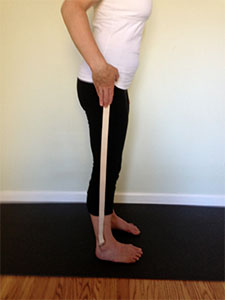The Importance of Alignment
I was first introduced to alignment in the context of yoga. The Iyengar Yoga system in particular is often characterized as emphasizing “alignment” in postures. It’s only recently, however, with the study of biomechanics, that I have begun to understand better what alignment really means and why it’s so important.
Katy Bowman, M.S., whose work I’ve been studying describes our alignment as being distinct from our posture. She points out that posture is cultural while alignment is based on objectivity. For example, some women I have talked to about posture and alignment have told me that their parents encouraged them not “to stick their butts out.” This view of posture is purely subjective as it is based a particular point of view. Alignment must be objective and must therefore be based solely on identifiable objective markers.
One such marker is the alignment of the hips relative to that of the knees and ankles. When standing in a bio-mechanically functional alignment the hip joints must sit directly over the center of the knees and the center of the outer ankle bones. Most of us tend to stand with the hips pushed forward of the knees and ankles. This tends to rotate the pelvis back (posteriorly) such that the pelvis sits a little “tucked”. To correct this misalignment we must back our hips up until our hip joints align over the outer ankle bones. When the hips are backed up this way it not only brings the pelvis and hips into a more functional alignment with the legs, it also tends to correct the “tuck” of the pelvis and rotate the pelvis back to neutral.

Figure 2
When I ask students to back their hips up this way, they usually say they feel like they are “sticking their butt out,” something some have been deliberately trying NOT to do! This is partly because they’ve gotten so accustomed to having their hips forward and their pelvis tucked that this misaligned position feels normal and the new position feels “strange” or “wrong” relative to what they are used to.
This example is a strong argument for using objective markers when aligning our bodies. We cannot rely on what “feels right” to us. When it comes to our own bodies we are not all that objective.
Besides the fact that it just feels right to push the hips forward, there’s another reason we tend to stand with our hips pushed forward – it’s easier! Standing with the hips forward is essentially us sitting loosely into the front of our hip joints. We often do the same thing to one side, swaying the hip out to act as a fulcrum to support our weight. This puts a great deal of stress on our hip joints and will eventually lead to pain. It takes a lot less effort to stand this way because the bones are in a position that doesn’t require (or to some extent even allow) important stabilizing muscles in our hips to work. When we back the hips up and align the hip joints with the outer ankles bones, it suddenly takes a lot more effort to stand!
This alignment of the hip joints helps a great deal in yoga with many of the standing postures. In the posture “samasthithahi,” for instance, where I am standing with my feet “hips width” apart (as opposed to “tadasana” where the feet are kept together), judging the position of the hips relative to the knees and ankles can be done by using a belt with a buckle as a plum bob to tell if my hips are lined vertically up over the outer ankle bones (see the diagram above). When I get the hips aligned I can feel that I’m anchored through the heels and the legs and hips are active and alive while I have a distinct sense of depth and space in the groin. Re-establishing neutral pelvis also does wonders for the function of the pelvic floor and is an essential step in the practice of the mula bandha.
Most importantly, aligning the hips properly in a yoga posture brings life into the posture. And this is not just true for samasthitahi but can be applied in many of the standing postures including trikonasana, parsvakonasana and ardhachandrasana to name just a few. In fact, this bringing of life into the postures can be manifested in just about any yoga posture when I can establish a better anchored and neutral pelvis.
Bio-mechanically sound alignment in yoga postures not only makes them better postures, it also helps us avoid injury and derive more benefit from our postures. So it’s worth the time and energy in a yoga practice to improve our alignment.
But ultimately, it’s our day to day activities that have the biggest impact on our health and function. Therefore alignment should not be limited to the domain of yoga but be a feature of how I stand, sit, walk and move throughout the day. In fact, the better my alignment in these every day activities the better my yoga postures will also become.
